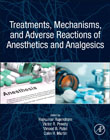
Treatments, Mechanisms, and Adverse Reactions of Anesthetics and Analgesics
Rajendram, Rajkumar
Preedy, Victor R.
Patel, Vinood B.
Martin, Colin R.
Treatments, Mechanisms, and Adverse Reactions of Anesthetics and Analgesics is an essential read for anyone working in pain management. The book addresses the onset of pain, the cause of the pain, and the administration of analgesia or anesthesia. The etiology of pain is complex and multi-factorial, which is made more complex with the use of analgesics and local or general anesthetics. This volume works to clarify all of the subjects pertinent to anesthesia and the brain, from their variety, modes of action, and adverse effects. Provides a broad range of topics related to the neuroscience of analgesics and anesthetics Contains chapter abstracts, key facts, a dictionary of terms, and summary points to aid in understanding Discusses anesthesia types, mechanisms of action and affiliated effects Helps readers navigate key areas for research and further clinical recommendations INDICE: I. Drugs and agents used in anesthesia and analgesia 1. Anesthesia for malignant hyperthermia susceptible patients 2. Use of dextran in regional anesthesia 3. Intraperitoneal local anesthetic agents in the management of post-operative pain 4. Automatic control of anesthesia via different vital signs 5. Non-opioid based analgesia in otolaryngology II. Mechanisms of action of drugs 6. Buprenorphine: mechanisms and applications 7. Caffeine usage in pain management 8. Chloroprocaine: features and applications 9. Clonidine: features and applications 10. An excursion into secondary pharmacology of fentanyls with potential implications for drug design: s1 receptor 11. Isoflurane: mechanisms and applications 12. The lidocaine patch: features and applications: post-thoracotomy pain and beyond 13. Memantine: features and application to chronic pain control 14. Midazolam: Perioperative administration 15. Intravenous paracetamol: features and applications 16. Prilocaine: mechanisms and applications 17. Sevoflurane: features and use in topical application for wound care 18. Tramadol as an analgesic III. Adverse effects, reactions and outcomes 19. Long-term effects of anaesthesia on the brain: an update on neurotoxicity 20. Neuraxial labour analgesia and breast feeding 21. Mechanistic Overview of How Opioid Analgesics Promote Constipation 22. Cognitive-behavioral therapy for opioid use disorder and chronic pain 23. Preoperative opioid and benzodiazepines: impact on adverse outcomes 24. Anesthetics, Malignant hyperthermia syndrome and Kv7 channels 25. Problems with epidural catheter 26. Headache after neuroaxial blocks: a focus on combined-epidural anesthesia 27. Liposomal bupivacaine, pain relief and adverse events 28. Adverse events associate with analgesics: a focus on paracetamol use IV. Novel and non-pharmacological aspects and treatments 29. Acronychia pedunculata leaves and usage in pain 30. Adansonia digitata and use in neuropathic pain: prostaglandins and beyond 31. Andrographis paniculata standardized extract (ParActin) and pain 32. Capsaicin: features usage in diabetic neuropathic pain 33. Cola nitida and Pain reliefLawrence 34. Analgesic effects of Ephedra Herb extract and ephedrine alkaloids-free Ephedra Herb extract (EFE) 35. Euphorbia bicolor (Euphorbiaceae) Latex Phytochemicals and applications to analgesia 36. Pain relieving activity of muntingia calabura l.: elucidation of possible mechanisms of action and identification of responsible phytoconstituents 37. Resolving neuroinflammation and pain with Maresin 1, a specialized pro-resolving lipid mediator 38. Therapeutic role of naringenin to alleviate inflammatory pain 39. Analgesic properties of Solanum paniculatum and S.torvum extracts 40. Dietary constituents contribute to local anesthetic agent: neurophysiologicals mechanism of nociceptive pain 41. Pain response following prenatal stress and its modulation by antioxidants 42. Physical activity and fitness in the prevention of musculoskeletal pain in youth 43. Linking aerobic exercise and childhood pain alleviation: a narrative 44. Physical activity and exercise in the management of musculoskeletal pain: a focus on fibromyalgia 45. Spinal cord stimulation and limb pain 46. Effectiveness of neural mobilization on pain and disability in individuals with musculoskeletal disorders 47. Virtual reality and applications to treating neck pain 48. Virtual reality-induced analgesia and dental pain 49. Vibrotactile devices, DentalVibe and local anesthesiaElitsa 50. Cooled radiofrequency ablation (CRFA) and osteoarthritis treatment for pain 51. Non-pharmacologic analgesic therapies: a focus on photobiomodulation, acustimulation and cryoanalgesia (ice) therapy 52. New coping strategies and self-education for chronic pain management: e-health 53. Postoperative Pain Management Truncal blocks in obstetric and gynecologic surgery
- ISBN: 978-0-12-820237-1
- Editorial: Academic Press
- Encuadernacion: Rústica
- Páginas: 680
- Fecha Publicación: 14/02/2022
- Nº Volúmenes: 1
- Idioma: Inglés
